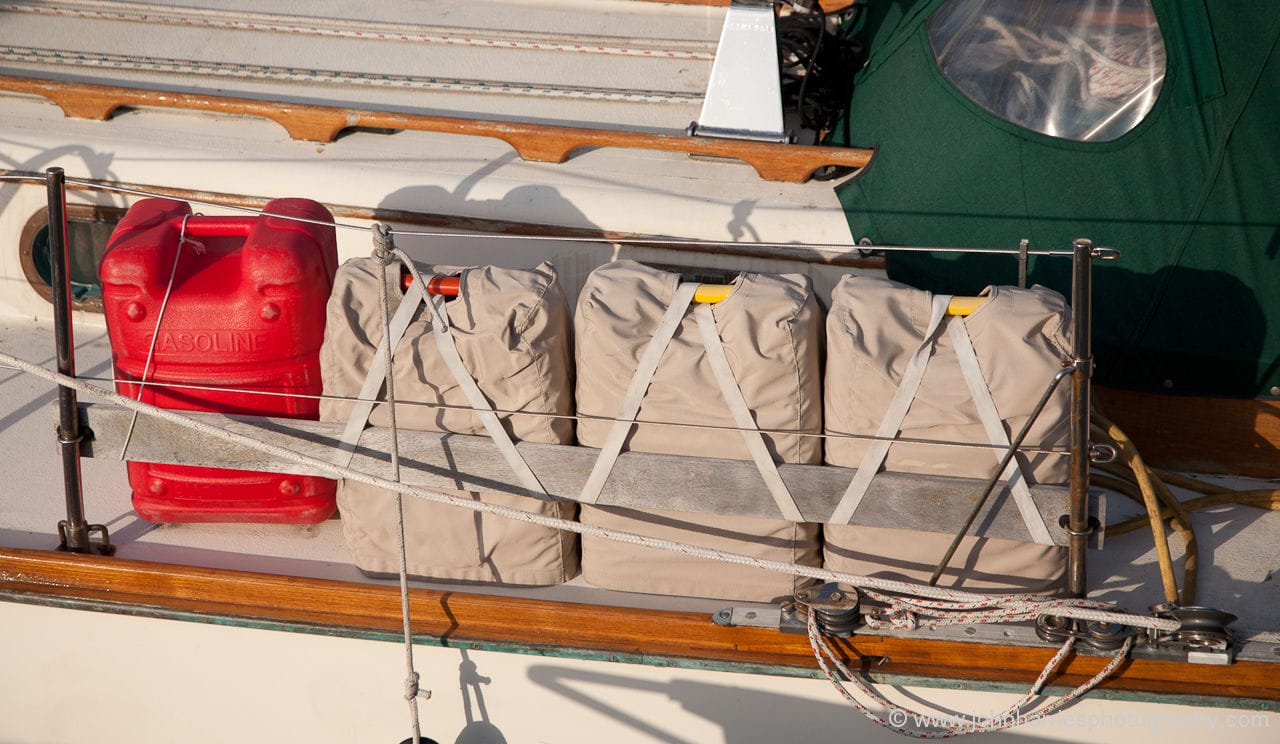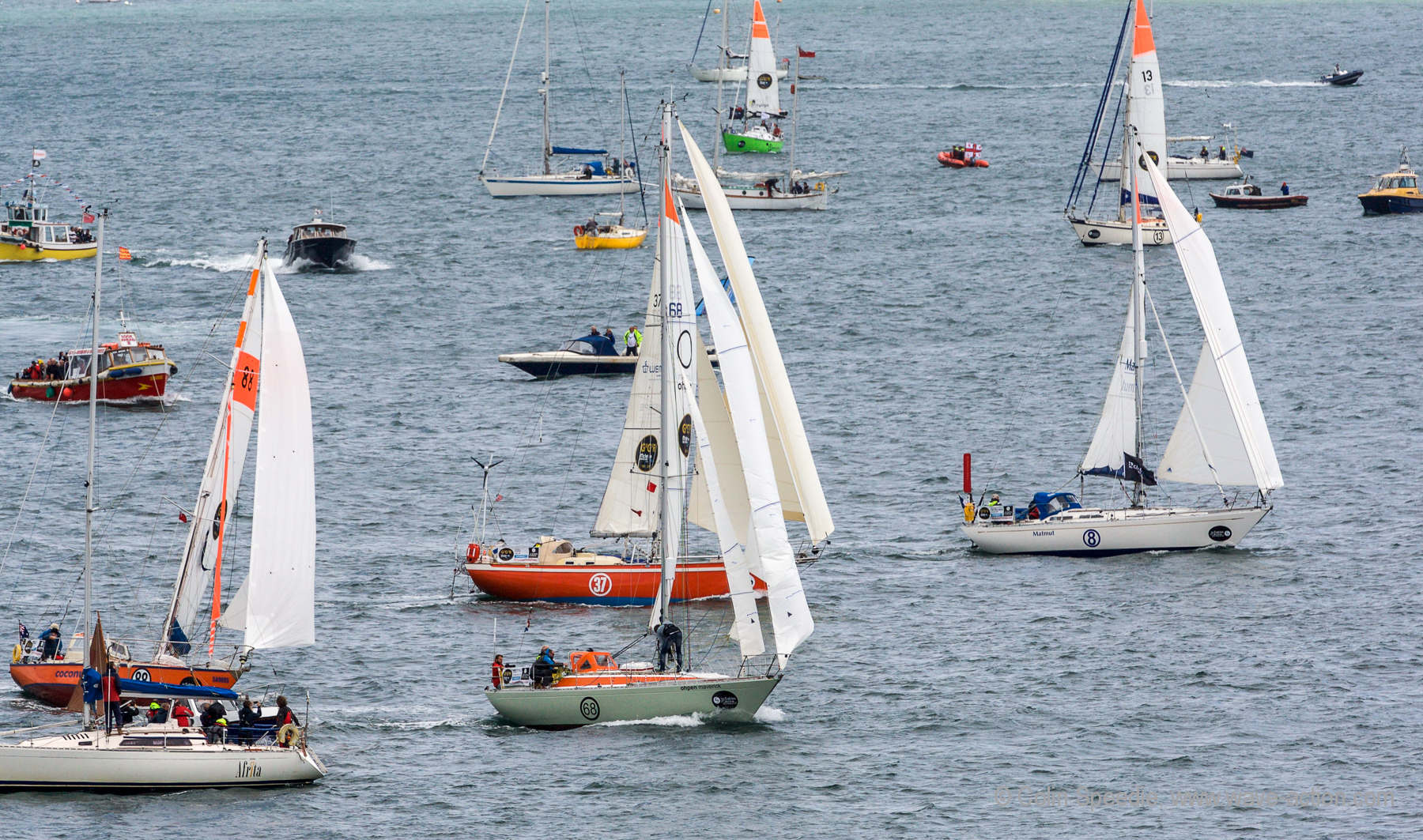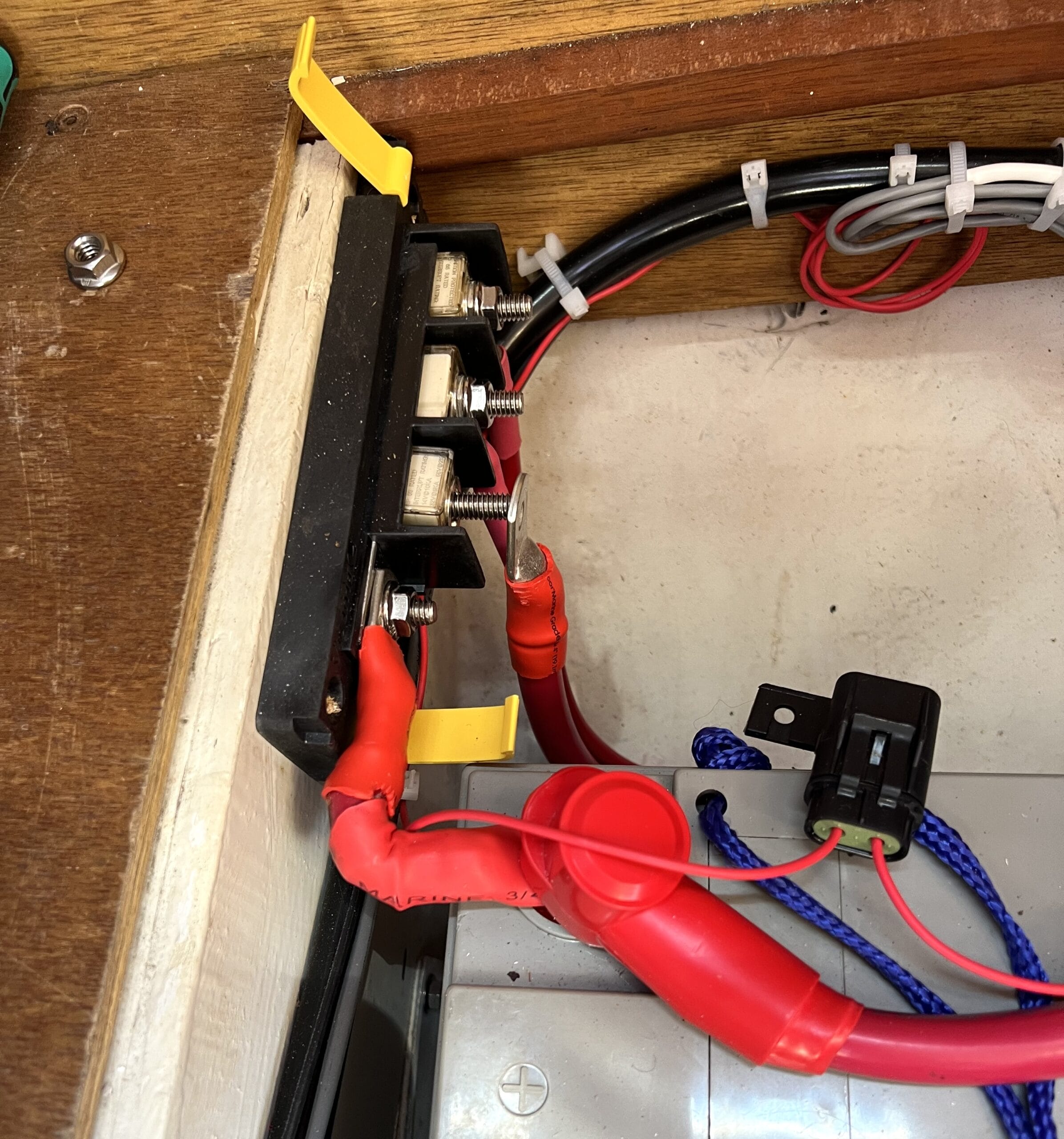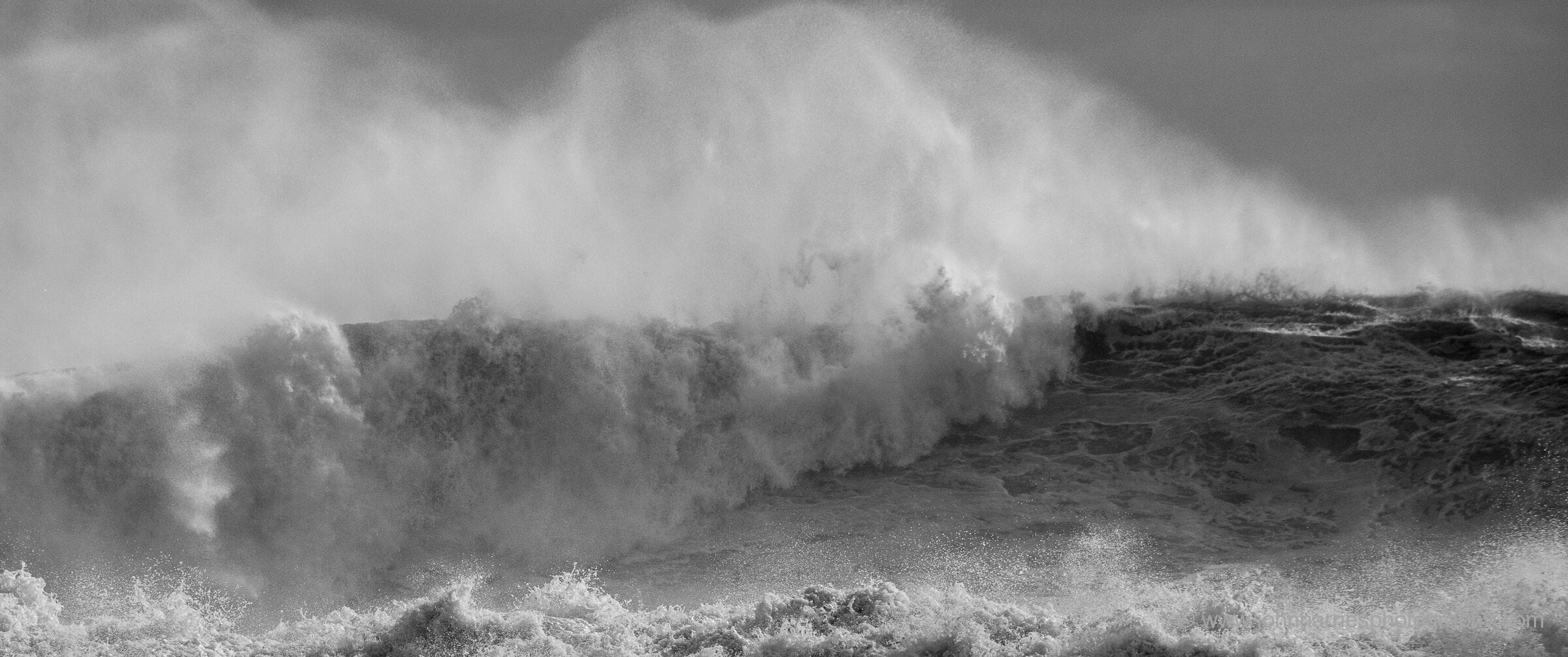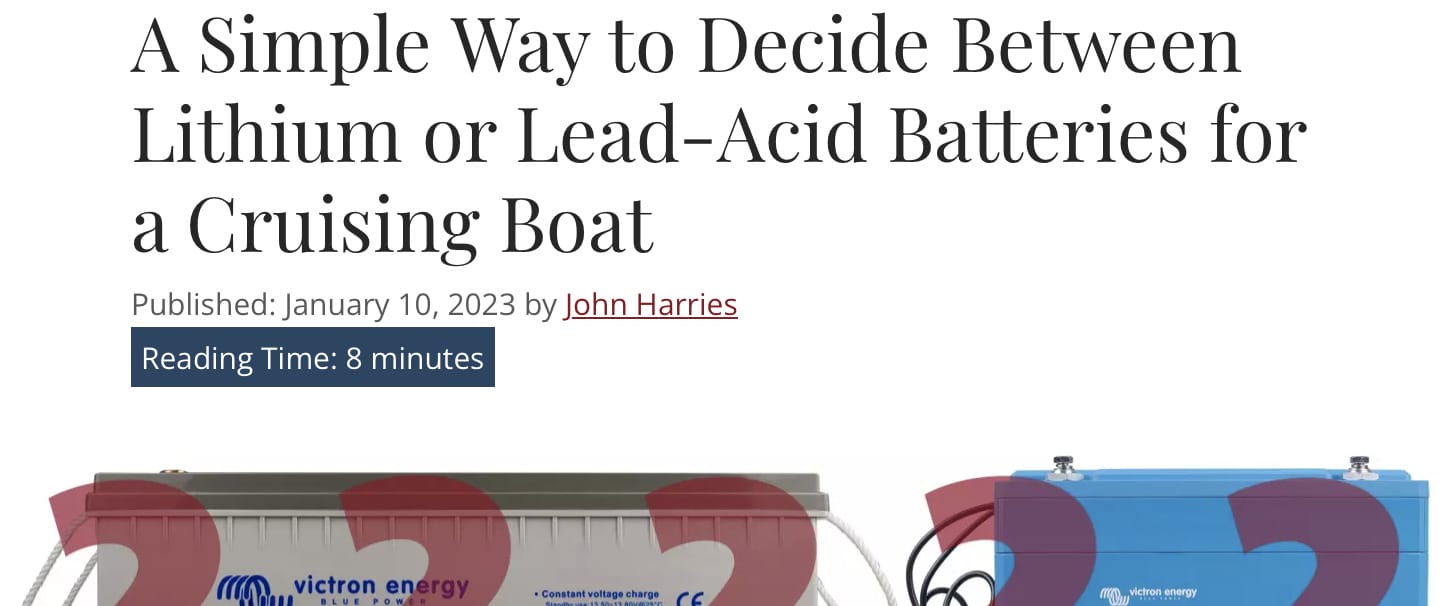
Tips, Tricks & Thoughts:
Tips
-
While Converting To Lithium
5 CommentsReading Time: 2 minutesFreeRead more: While Converting To LithiumMember Rob sent us the above photo of the very cool (in more ways than one) equipment and battery bay he and his installer built in the aft cabin of his 2002 Beneteau Oceanis 473 while they were changing the boat over to a lithium house (service) bank. Prior to that change, as is so […]
-
Loos Rigging Tension Gauge
2 CommentsReading Time: < 1 minuteFreeRead more: Loos Rigging Tension GaugeA cool tool for tuning a one-design boat where the settings are known, as they are on our J/109. Probably not worth the money otherwise. Here’s how to tune a rig without.
-
Small Problems Add Up To Big Problems
7 CommentsReading Time: 2 minutesFreeRead more: Small Problems Add Up To Big ProblemsMember Tim Newson sent us the attached account of a serious situation that developed when several small oversights and maintenance failures came home to roost during a challenging early winter voyage across the North Sea—only Brits would think such a cruise might be fun! …OK, I have done that sort of thing, too, but then […]
-
Question and Answer—Limited Fuel Range Voyage
2 CommentsReading Time: 2 minutesFreeRead more: Question and Answer—Limited Fuel Range VoyageMember, George asked: I’m presently faced with challenge of a transatlantic delivery Maine- Azores and beyond. Boat is old 1978 NY 40, Palmer Johnson built. Pretty solid for IOR era as it was intended for Bermuda races as well as inshore events. Stickey issue is the 12 gallon fuel tank! I don’t like lashing 5 […]
-
Thoughts on The Golden Globe Race 2022
9 CommentsReading Time: 2 minutesFreeRead more: Thoughts on The Golden Globe Race 2022Member Jim asked: So now that GGR 2022 is in the final stretch – What do you think? Seems like the later start had some benefits – if I recall correctly one boat sank (auto-pilot broke off?) otherwise barnacles seems to be the biggest issue… and kudos to Kirsten! Yes, the later start was a […]
-
Answer to Electrical Quiz
0 CommentsReading Time: < 1 minuteFreeRead more: Answer to Electrical QuizA bit over a week ago I posted an electrical quiz question. A couple of members came close in the comments, but no one got it exactly right. I had the volt meter connected between a reference anode, immersed in the water next to the boat, and the boat’s bond system, and was looking to […]
-
Jordan Series Drogue Works Even if Caught Beam On
2 CommentsReading Time: < 1 minuteFreeRead more: Jordan Series Drogue Works Even if Caught Beam OnSusanne Huber-Curphy and I were chatting by email about her use of the Jordan Series Drogue, our (and her) recommended storm-survival gear, when she clarified a point I think many people worry about, unnecessarily as it turns out: The most amazing thing of the JSD is that after a front has passed with a dramatic […]
-
AAC Site Slow Down
0 CommentsReading Time: < 1 minuteFreeRead more: AAC Site Slow DownWe had a three-hour slowdown on Sunday afternoon (AST) that made the site pretty much unusable. This was the result of a new site-search engine that we are installing that was building an index and ran amok. Fixed now. Sorry for the problem.
-
Instrument Loads
1 CommentReading Time: < 1 minuteFreeRead more: Instrument LoadsSeems like a lot of cruisers are leaving their instrumentation on, even when at anchor, these days. Do what you want, but this practice could push you into a major electrical system makeover that might not be necessary if we just turned that stuff off. The above photo shows the load (battery monitor to the […]
-
NMEA 2000 Trouble Shooting Kit
0 CommentsReading Time: 2 minutesFreeRead more: NMEA 2000 Trouble Shooting KitI’m in the throws of installing a new autopilot and radar on our new-to-us J/109. As part of that I cleaned up the dogs breakfast of a NMEA 2000 network the boat came with to make it both easier to trouble shoot and hopefully more reliable, particularly since this new kit required adding quite a […]
-
Stopping Rigging Hum Q & A
8 CommentsReading Time: 2 minutesFreeRead more: Stopping Rigging Hum Q & AMember Arne asked: When I tuned the rig on my OVNI, it started vibrating/resonating in the wind when on anchor. It starts at fairly low wind speeds, and I can’t tell exactly where in the rig it is. I can sometimes feel some vibrations in the shrouds. It sounds like a motorboat approaching a couple […]
-
Is Reading Time a Good Addition to AAC?
20 CommentsReading Time: < 1 minuteFreeRead more: Is Reading Time a Good Addition to AAC?Early this week we added a reading time estimate to the header of every article (but not these Tips). The idea is to show how much information you can get from a small investment in time at AAC, particularly when compared to trying to get technical information from YouTube, podcasts, or the biggest time sink […]
-
Turnbuckle Securing Hack
6 CommentsReading Time: < 1 minuteFreeRead more: Turnbuckle Securing HackHere’s a quick way to secure turnbuckles with no need for taping and that is quick to take off when we need to adjust the rig. The secret is selecting a ring-ding (a technical term that shows the user is a real professional rigger) that is just too big in diameter to allow the barrel […]
-
A very bad place to put a solar panel
4 CommentsReading Time: < 1 minuteFreeRead more: A very bad place to put a solar panelSeriously? One wave strike, or even a gale, and this will end very badly. More on why we should not do stuff like this, at least if we plan to go offshore.
-
Electrical Quiz
10 CommentsReading Time: < 1 minuteFreeRead more: Electrical QuizQuiz is closed, here’s the answer. Why am I methodically disconnecting each load from the battery, and then reconnecting it while looking at a volt meter? And what’s the meter connected to? Answer in the comments: First right answer wins an Adventure 40 T-shirt.
-
Preventing Unintended Jib Unfurls
7 CommentsReading Time: < 1 minuteFreeRead more: Preventing Unintended Jib UnfurlsThe furler line is only secured by a cam cleat (under dodger flap in shadow) on our J/109, so when leaving the boat we clove hitch it around the winch. Also note the sheet is half hitched around the standing part. Before leaving the boat we also make very sure the jib is neatly rolled […]
-
A Not Boring Accountant
0 CommentsReading Time: 2 minutesFreeRead more: A Not Boring AccountantMark Goodfield was our accountant and tax advisor, both personally and for AAC, for some ten years until he retired from public practice, and he never steered us wrong. He has blogged about personal finances, investing, tax planning, and accounting for some 15 years (guess) as the Blunt Bean Counter. Given that, if we want […]
-
McCurdy and Rhodes 56 For Sale
5 CommentsReading Time: 4 minutesFreeRead more: McCurdy and Rhodes 56 For SaleThe McCurdy and Rhodes 56 that we owned and loved for thirty years is for sale again. The asking price has recently been dropped to CAD$349,000 / ~US$259,000. This is a great boat at any price, but at this new price she represents a once in a very-long-while opportunity to buy an offshore-ready boat at […]
-
Mono- or Multihull?
8 CommentsReading Time: < 1 minuteFreeRead more: Mono- or Multihull?As I have said many times before, I’m agnostic about the number of hulls a cruising boat should have. There are benefits and drawbacks to one, two, or three. That said, I do have a soft spot for some boats with three hulls, but that’s another post. Anyway, I came across this good article comparing […]
-
Servo-pendulum is Not Bullet Proof Either
4 CommentsReading Time: < 1 minuteFreeRead more: Servo-pendulum is Not Bullet Proof EitherA few weeks ago I pondered the very high loads that auxiliary-rudder self-steering gears put on themselves and the parts of the boat they are bolted to, based on the failure of Simon Curwen’s Hydrovane gear while leading the GGR. Now we are getting reports that Abhilash Tomy is having a hell of a time […]
-
Invaluable Measurement Tools
2 CommentsReading Time: < 1 minuteFreeRead more: Invaluable Measurement ToolsI have a couple of tape measures (one metric, the other imperial) in my tool bag, and even have a really nice digital calliper for when dead-nuts measurement is required, but the two measurement tools in my kit that get the most use are a cheap pocket calliper (top photo) and an even cheaper metal […]
-
Inflatable Boat Maintenance Wisdom
3 CommentsReading Time: < 1 minuteFreeRead more: Inflatable Boat Maintenance WisdomI just got off the phone with a local guy who repairs inflatable boats. Seems like he really knows of what he speaks. I learned a few things: He is going to rehab our nearly four-decade old Avon. If it goes another 20 years I’m thinking I might be done with it. Final tip from […]
-
The Perfect Mallet
2 CommentsReading Time: < 1 minuteFreeRead more: The Perfect MalletI pretty much never use a hard-headed hammer on a boat; in fact, I don’t even have one in my onboard tool kit on our new-to-us J/109. But I use a mallet often to move something stuck without damaging it, or drive a punch or chisel. This one from Lixie is just the right weight […]
-
Garmin Cut Vesper Users Loose
25 CommentsReading Time: 2 minutesFreeRead more: Garmin Cut Vesper Users LooseAlthough we had a lot of trouble with our first Vesper AIS, I have long been a fan of their products, with the exception of the Cortex, which tried to do too many things in one unit and had a lot of issues as a result. When Garmin bought Vesper I had a sense of […]
-
Lubricate Steering Chains and Cables
3 CommentsReading Time: < 1 minuteFreeRead more: Lubricate Steering Chains and CablesI mentioned in another tip that I have just finished a full maintenance on the steering gear on our new-to-us J/109 and that nothing was properly lubricated before I started and probably never had been. On that subject, I have long noticed that the chain and steering cables on many boats are bereft of any […]




